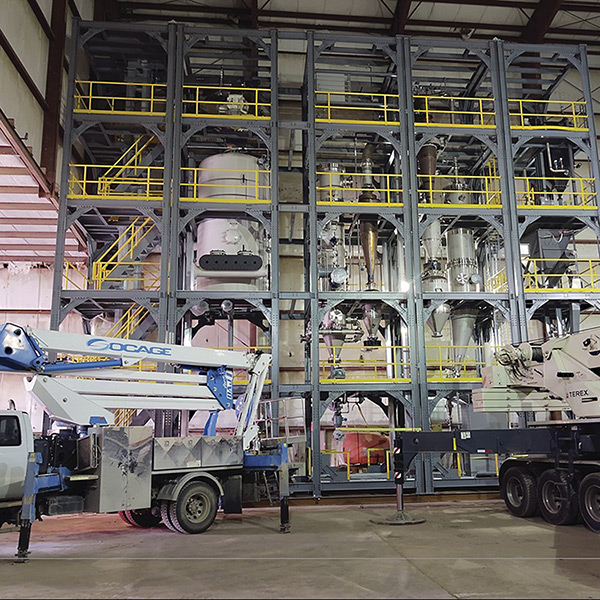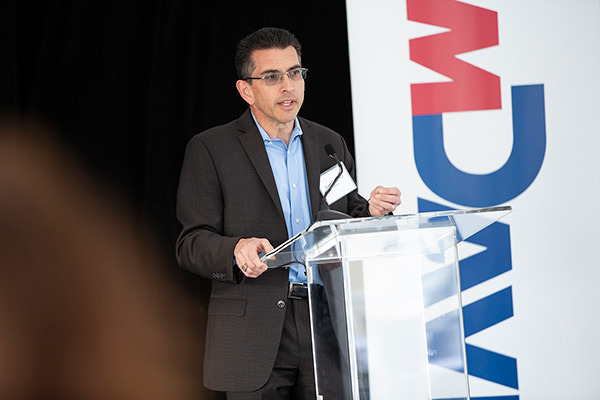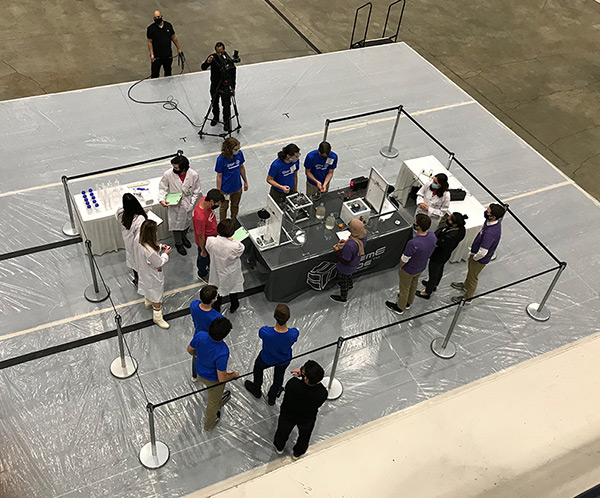Bigger is not always better. The Rapid Advancement in Process Intensification Deployment (RAPID) Manufacturing Institute is transforming process industries by advancing modular technology at the factory level and within factories. Smaller, modular factories could be sited close to raw materials, close to end users, and/or in areas where jobs are needed.

“The concept of modular manufacturing allows manufacturers to earn their way into scale,” RAPID CEO Bill Grieco said. “This is a tool that will enable distributed manufacturing in an industry that historically hasn’t had that. It’s a very different paradigm for our industry.”
In five years, RAPID has spent $125 million in federal funds and member matching funds to finance 38 research and development projects, with 32 still running at different stages of completion, Grieco said.
“Historically in our industries, manufacturers have taken advantage of economies of scale—if we wanted 10 times the capacity to produce polymer, we built a very large plant at least 10 times larger than the prior version,” Grieco said. “With a bigger facility, you have only one set of waste-handling equipment, only one steam boiler.”
But these bigger manufacturing plants often have hidden costs. For example, chemical plants are often stick built in the field on the job site, with relatively high costs and cost overruns, he said.
Underutilized capacity—which will be needed in the future but not now—is a significant cost driver.
“If you have a new-to-the-world product and you believe the market five years down the road will be 100 million pounds of this product, but in years one and two, the market will be only a few tens of millions of pounds, you don’t want to build a gigantic factory to produce hundreds of millions of pounds now because you lose a lot of money,” Grieco said.

Instead of building a factory to meet demand anticipated in 10 years, a manufacturer could build the first modular plant to produce 10 million pounds, then build a second plant producing 10 million pounds, adding more as demand grows, Grieco said.
“What we’re pushing is reducing the size of the individual plant, then mass producing the plant, taking advantage of economies of scale by making more of the same factory,” Grieco said.
Manufacturers will start with one, smaller factory, or modules within a factory, for testing, debugging, proof of concept, and demonstrations, he said. Manufacturers will achieve economies of scale by building tens, hundreds or thousands of factories or modules.
“The standardization and mass production of individual operations and the standardization and mass manufacturing of modules have not historically existed in our industry,” Grieco said.
Boosting the triple bottom line
RAPID, a Manufacturing USA Institute, is working aggressively to help manufacturers reduce their energy footprint, shrink their overall footprint and drive sustainability.
Instead of focusing on only one component, RAPID’s end goal is boosting the triple bottom line—driving environmentalism/sustainability, taking care of the workforce and improving profitability, Grieco said.

“We’re taking the approach of yield improvement, capital footprint reduction, driving profitability and driving sustainability all at the same time,” he said. “What we’re proposing and testing in the field are projects that underpin the ability for the chemical energy to drive sustainability and decarbonization. You cannot do that without these tools for process intensification and modularization.”
Part of the modular approach is to collapse many large pieces of equipment, each doing one dedicated task, down to fewer, modular units designed to perform multiple functions, he said.
“You can pack more capabilities into smaller-scale equipment,” Grieco said. “Rather than having one giant piece of equipment that does batch operations for many different chemicals, you can have a model where smaller pieces of equipment run with some level of flexibility. The different ways of operating those pieces of equipment offers robustness, redundancy and resiliency. The equipment, and the factory, can be a little more agile.”
From batch to continuous processing
One project at a midsize chemical company took a batch process for making three specialty chemicals and converted manufacturing to a single continuous process, Grieco said. The result: a higher-quality product, higher yield, 30 percent lower operating costs, less energy use, and 10 percent of both the capital cost and footprint of the previous system.
“Raw materials flow in, and as raw materials pass through the system, the purified product comes out the other end,” he said.
With such a system, a manufacturer might be able to have an entire spare manufacturing line sitting on hot standby if the primary line needed to be repaired, Grieco said.
In many cases, production is converted from batch processes to a continuous production, Grieco said, citing strong interest in the pharmaceutical and chemical sectors for such conversions.
“Many manufacturers are realizing that conversion from batch to continuous manufacturing allows them to control quality, size, capital infrastructure related to equipment, and to drive down costs and risks,” Grieco said. “Selectively applied, continuous production also allows the integration of electricity and processes that use electricity more efficiently into the chemical industry,” he said.
RAPID has helped startup IFS, Durham, N.C., which has developed an electric-powered process heating technology that heats flowing fluids from the middle out, connect to engaged members of the process manufacturing community, CEO Francesco Aimone said.
Aimone compared IFS’ technology, developed by Chief Science Officer George Sadler, to heating a pot on a stove with a choice between letting the pot heat up gradually to keep the heating impact low and turning the burner up to maximum levels for quick results. “We’re making it so you don’t have to choose between the two options,” he said. “We can find more surface area and give you more gentle heating.”
This middle-out heating process allows heating units to be 10 times smaller and empowers them to perform eight to 10 times better, he said.
‘Number up instead of scale up’
While IFS knew the food and beverage sector well, the company did not understand manufacturing processes in other sectors, such as specialty chemicals, oil and gas and others where its emerging technology could help, Aimone said.
“RAPID has given us a better sense of where technology like ours can make a big difference outside our core competencies,” Aimone said.

As an early-stage company, IFS’ technology aligns well with the principles of building smaller, modularized systems, Aimone said, “to number up instead of scaling up.” IFS has begun deploying small-scale equipment and demonstration projects and plans to produce production-scale equipment by the end of 2022.
Modular factories can help alleviate supply chain issues, Grieco said. Over the past two years—partly but not wholly because of the pandemic—the United States has experienced disruptions in supply chains for therapeutic drugs, nonwoven paper goods, medicines for treating COVID-19 and other medicines, many of which are no longer manufactured in the United States because the capability to make key chemical components is not well known.
For example, modular manufacturing can allow small domestic chemical companies to stand up capacity very quickly to make those vital chemical components.
“We would be able to reshore these specialty chemical raw materials and therapeutics faster than we’ve been able to do,” Grieco said.
The modular factory approach also enables distributed manufacturing, making it easier to site factories based on where raw materials, end users and workers are.
“Think about the coal-impacted communities in Appalachia and along the Ohio River Valley that have been depressed for a long period of time,” Grieco said. “A manufacturer could take production facilities and distribute them to wellheads in that region and create jobs.” Former miners and workers who supported mining could be cross trained to operate and maintain small modular factories, Grieco said.
Modular manufacturing also could help companies better navigate weather-related issues such as the ice storm that shut down Houston in early 2021, Grieco said.
“If a company had its infrastructure distributed all over North America, only one manufacturing node would be taken out instead of a significant part of capacity,” he said.
For example, a chemical company could site a small, modular factory near one of its primary customers for just-in-time delivery, Grieco said. In the natural gas industry, modular plants could convert natural gas directly from the wellhead to fungible liquid chemical ready for use, lessening the need for compressed natural gas pipelines, he said. When a wellhead stopped producing, the unit could be easily moved to a productive wellhead.
Modular factories also could make it easier to derive value from biomass byproducts that are fairly low value but also low density, and thus not worth it to ship, he said. Such a factory could be sited near where corn or sugar cane is harvested, for example, and convert the stranded, low-value raw materials into a more-valuable intermediate liquid chemical.
“Two decades into the future, the entire form of the factory could look very different,” Grieco said. “This is going to work only if we educate the current and the next generation of the workforce to think differently,” Grieco said.
"Factory" - Google News
February 10, 2022 at 08:00PM
https://ift.tt/ul93Mr8
RAPID's case for modular factories - Advanced Manufacturing
"Factory" - Google News
https://ift.tt/7wP26VO
Shoes Man Tutorial
Pos News Update
Meme Update
Korean Entertainment News
Japan News Update
Bagikan Berita Ini














0 Response to "RAPID's case for modular factories - Advanced Manufacturing"
Post a Comment